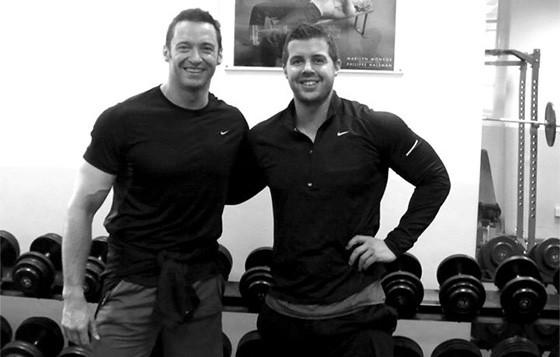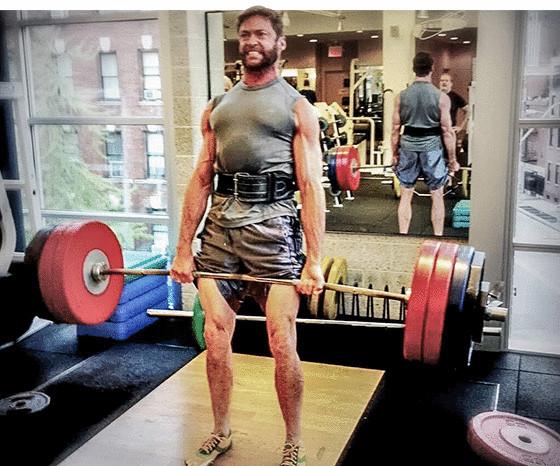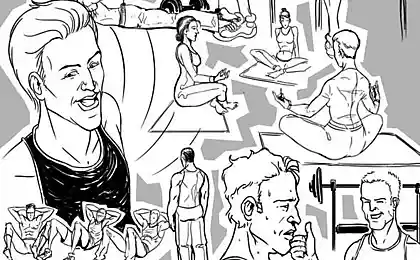468
Coach David Kingsbury: how to create an image for Hugh Jackman
In the film, Wolverine is over 100 years old, he speaks seven foreign languages as well as Japanese technology of the samurai. He has steel bones and super strong claws that can break any material. And Hugh Jackman is more than up to its character! In their present 46 he continues to be in great shape and looks a decade younger.

Jackman has always tried to maintain a healthy body, but it wasn't enough for a superhero, until I started working on the individual program for "Wolverine" with coach David Kingsbury, who later became his personal trainer. Kingsbury offered his mentee a comprehensive approach in creating the image of Wolverine: diet, increase exercise, the training plan. More telling David himself.
Tell us a little about yourself. How do you coach the stars?
David Kingsbury: Actually, I had the intention to work with athletes. For 5 years I trained Thai fighters Muay Thai to prepare for professional fights. After returning to his native Britain I set out to open a club of mixed martial arts (MMA) near the house. I once spoke about this idea with one of his clients — a successful businessman who worked for Pinewood studios. He introduced me to a team of realtors with which I have a small room for training — as it later turned out, directly at the Studio. After a few years the business began to grow and flourish, and I opened a full-fledged gym. Since he was in the Studio, it was done by many people from the film industry — from producers to office workers. My client is a producer were impressed with their personal results, and one day invited me to participate in the project of the new film. It was 4 years ago, and I never so close contact with the film industry.
How did you start working with Hugh Jackman?
DK: When I finished my work at Pinewood studios, I got a call coordinator, the Director of "Les Miserables", who told me that one actor would like to meet with me, and if he chooses me, I'll get to work with him. I had no idea who he was talking about. At the meeting with Hugh and we discussed what goals it pursues and what he wanted to achieve when creating the image of Wolverine.
In what form it was when you first began to work together?
DK: He was in great shape, has just finished acting in "Les Miserables." After a Broadway show he was thinner than usual. In addition, the main goal in "Les Miserables" was the maintenance of the most slim form — how it is possible for the male image, while maintaining the ratio of muscle and strength which should have been the hero.
What was the purpose for the image of Wolverine?
DK: First of all, to surpass the previous characters and to find relief the muscles while controlling weight gain. To achieve this, we trained for 5 months, but it should be noted that for some time we have been limited by the fact that he starred in "Les Miserables." Therefore, we can say that the main program lasted 3-4 months.
What you have formed a relationship?
DK: I work with Hugh here for 2 years, and we are working now on their fourth project — "X-Men: Days of future past". We have many common interests, so we easily find a common language. If you don't get along with my client, you will not be able to hold together for an hour or two every day, 6 days a week for 2 years! For the coach it is also very important. Hugh has always been motivated and remained a supporter of training, so it didn't need to spur, to baby or to persuade. We just practiced together, and I gradually increased the intensity of subsequent workouts. Each approach required considerable effort, so doing it, we motivated each other. We were both on about the same level in strength and endurance, so we had something like a competition between themselves who will be the first to make a breakthrough and raise the bar higher.

What was the most significant problem in the preparation of the Wolverines?
DK: the Lack of rest. We trained very early in the morning for a long period. Sometimes we had only 5-6 hours of sleep. In those days I was even allowed myself to take NAPs during the day when it was possible.
What method or approach did you use?
DK: at First, Hugh was doing a lot of work force, training with me. He usually worked in the mode of 8-12 reps, but I advised him to work in the 1-5 reps with heavy weight to stimulate myofibrillar hypertrophy muscle. After working with large weights was finished, we moved on to another scheme, involving a larger number of reps that stimulates sarcoplasmic hypertrophy of the muscles, which increases endurance of the body. Thus, in the regime of small number of repetitions with large weights, developing strength of muscles, and workout with lots of reps with less weight adds energy to your body and increases your stamina. I always try to combine power and cardio activities because this scheme is most effective.

How Hugh had achieved such prominence body? It seems that there is not a drop of fat!
DK: He used it for training. We broke the training into 2 parts: building muscle and "drying".
What was the diet of his power?
DK: the Food was diverse and varied depending on one or another stage of training. Although from the beginning of training, we stuck to one principle: a cyclic carbohydrate intake. That is, on training days, consume foods high in carbohydrates and rest days — low. In the basis of a diet is a system of counting calories and macronutrients to achieve certain goals. Hugh all the time adhered to a healthy diet and, more importantly, correctly spent calories. As for food, we used nothing supernatural. Here is an example of the diet of Wolverines in training day:
Option 1:
— eggs
— oatmeal
Option 2:
— meat
sweet potatoes
— broccoli
Option 3:
— chicken meat
brown rice
— spinach
Option 4:
fish
— avocado
— broccoli
Sounds good. What about supplements?
DK: We used a pre-workout formula without sugar and substitutes. The drug was in tablets, so we can adjust the creatine content. In the process of training to build muscle it will need more in the "drying" less, and so on. In addition, we also used pre - and potrenirovatsy complexes BCAA. Because the training took place mostly in the morning, the intake of BCAA was an important component contributing to the compaction of muscle mass. During the "drying" used L-carnitine to speed up metabolism and enrichment of amino acids.
Tell me about the program where you worked with Hugh.
DK: the goal of the first stage was to strengthen the muscles, increase the contractility of the muscles, as well as their volume, while the fat content in the body was reduced to a minimum. The program envisaged an increase in load (weight) that you can get a progressive effect. At first glance, this system seems complicated, but once you start to use it and achieve results, it becomes very easy to train. The program lasts for 4 weeks, during which the number of repetitions for the major exercises is changed every week. During the first 3 weeks the increase in weight weekly, on the 4th week reduced such that it was possible to perform 10 repetitions. To determine the weight that you want to work weekly when performing basic exercises, we developed a special calculation system in percentage. Each week the weight was calculated based on the maximum weight that we could work, and the number of repetitions with that weight. Thus, to determine the maximum weight that you can perform maximum 1 repetition (W1RM), respectively, and 95% of that weight is your weight.
Basic exercises:
— bench press;
— squats;
pull — UPS with load;
— dead lift.
1 week Approaches
Repeat
Weight
60% of W1RM
65% of W1RM
75% of W1RM
75% of W1RM
Week 2 Approaches
Repeat
Weight
65% of W1RM
75% of W1RM
85% of W1RM
85% of W1RM
Week 3 Approaches
Repeat
Weight
70% of W1RM
80% of W1RM
90% of W1RM
90% of W1RM
Week 4 Approaches
Repeat
Weight
40% of W1RM
50% of W1RM
60% of W1RM
60% of W1RM
When the first stage of a 4-week block is made, add another 5-10% to your maximum working weight for 1 repetition (W1RM). If efficiency is low, add 5% if You are rapidly progressing and feel comfortable, then add 10%. Use this rule when calculating each 4-week block.
Train and eat like a mutant and give your body the opportunity of development and improvement!
Source: fitfixed.com

Jackman has always tried to maintain a healthy body, but it wasn't enough for a superhero, until I started working on the individual program for "Wolverine" with coach David Kingsbury, who later became his personal trainer. Kingsbury offered his mentee a comprehensive approach in creating the image of Wolverine: diet, increase exercise, the training plan. More telling David himself.
Tell us a little about yourself. How do you coach the stars?
David Kingsbury: Actually, I had the intention to work with athletes. For 5 years I trained Thai fighters Muay Thai to prepare for professional fights. After returning to his native Britain I set out to open a club of mixed martial arts (MMA) near the house. I once spoke about this idea with one of his clients — a successful businessman who worked for Pinewood studios. He introduced me to a team of realtors with which I have a small room for training — as it later turned out, directly at the Studio. After a few years the business began to grow and flourish, and I opened a full-fledged gym. Since he was in the Studio, it was done by many people from the film industry — from producers to office workers. My client is a producer were impressed with their personal results, and one day invited me to participate in the project of the new film. It was 4 years ago, and I never so close contact with the film industry.
How did you start working with Hugh Jackman?
DK: When I finished my work at Pinewood studios, I got a call coordinator, the Director of "Les Miserables", who told me that one actor would like to meet with me, and if he chooses me, I'll get to work with him. I had no idea who he was talking about. At the meeting with Hugh and we discussed what goals it pursues and what he wanted to achieve when creating the image of Wolverine.
In what form it was when you first began to work together?
DK: He was in great shape, has just finished acting in "Les Miserables." After a Broadway show he was thinner than usual. In addition, the main goal in "Les Miserables" was the maintenance of the most slim form — how it is possible for the male image, while maintaining the ratio of muscle and strength which should have been the hero.
What was the purpose for the image of Wolverine?
DK: First of all, to surpass the previous characters and to find relief the muscles while controlling weight gain. To achieve this, we trained for 5 months, but it should be noted that for some time we have been limited by the fact that he starred in "Les Miserables." Therefore, we can say that the main program lasted 3-4 months.
What you have formed a relationship?
DK: I work with Hugh here for 2 years, and we are working now on their fourth project — "X-Men: Days of future past". We have many common interests, so we easily find a common language. If you don't get along with my client, you will not be able to hold together for an hour or two every day, 6 days a week for 2 years! For the coach it is also very important. Hugh has always been motivated and remained a supporter of training, so it didn't need to spur, to baby or to persuade. We just practiced together, and I gradually increased the intensity of subsequent workouts. Each approach required considerable effort, so doing it, we motivated each other. We were both on about the same level in strength and endurance, so we had something like a competition between themselves who will be the first to make a breakthrough and raise the bar higher.

What was the most significant problem in the preparation of the Wolverines?
DK: the Lack of rest. We trained very early in the morning for a long period. Sometimes we had only 5-6 hours of sleep. In those days I was even allowed myself to take NAPs during the day when it was possible.
What method or approach did you use?
DK: at First, Hugh was doing a lot of work force, training with me. He usually worked in the mode of 8-12 reps, but I advised him to work in the 1-5 reps with heavy weight to stimulate myofibrillar hypertrophy muscle. After working with large weights was finished, we moved on to another scheme, involving a larger number of reps that stimulates sarcoplasmic hypertrophy of the muscles, which increases endurance of the body. Thus, in the regime of small number of repetitions with large weights, developing strength of muscles, and workout with lots of reps with less weight adds energy to your body and increases your stamina. I always try to combine power and cardio activities because this scheme is most effective.

How Hugh had achieved such prominence body? It seems that there is not a drop of fat!
DK: He used it for training. We broke the training into 2 parts: building muscle and "drying".
What was the diet of his power?
DK: the Food was diverse and varied depending on one or another stage of training. Although from the beginning of training, we stuck to one principle: a cyclic carbohydrate intake. That is, on training days, consume foods high in carbohydrates and rest days — low. In the basis of a diet is a system of counting calories and macronutrients to achieve certain goals. Hugh all the time adhered to a healthy diet and, more importantly, correctly spent calories. As for food, we used nothing supernatural. Here is an example of the diet of Wolverines in training day:
Option 1:
— eggs
— oatmeal
Option 2:
— meat
sweet potatoes
— broccoli
Option 3:
— chicken meat
brown rice
— spinach
Option 4:
fish
— avocado
— broccoli
Sounds good. What about supplements?
DK: We used a pre-workout formula without sugar and substitutes. The drug was in tablets, so we can adjust the creatine content. In the process of training to build muscle it will need more in the "drying" less, and so on. In addition, we also used pre - and potrenirovatsy complexes BCAA. Because the training took place mostly in the morning, the intake of BCAA was an important component contributing to the compaction of muscle mass. During the "drying" used L-carnitine to speed up metabolism and enrichment of amino acids.
Tell me about the program where you worked with Hugh.
DK: the goal of the first stage was to strengthen the muscles, increase the contractility of the muscles, as well as their volume, while the fat content in the body was reduced to a minimum. The program envisaged an increase in load (weight) that you can get a progressive effect. At first glance, this system seems complicated, but once you start to use it and achieve results, it becomes very easy to train. The program lasts for 4 weeks, during which the number of repetitions for the major exercises is changed every week. During the first 3 weeks the increase in weight weekly, on the 4th week reduced such that it was possible to perform 10 repetitions. To determine the weight that you want to work weekly when performing basic exercises, we developed a special calculation system in percentage. Each week the weight was calculated based on the maximum weight that we could work, and the number of repetitions with that weight. Thus, to determine the maximum weight that you can perform maximum 1 repetition (W1RM), respectively, and 95% of that weight is your weight.
Basic exercises:
— bench press;
— squats;
pull — UPS with load;
— dead lift.
1 week Approaches
Repeat
Weight
60% of W1RM
65% of W1RM
75% of W1RM
75% of W1RM
Week 2 Approaches
Repeat
Weight
65% of W1RM
75% of W1RM
85% of W1RM
85% of W1RM
Week 3 Approaches
Repeat
Weight
70% of W1RM
80% of W1RM
90% of W1RM
90% of W1RM
Week 4 Approaches
Repeat
Weight
40% of W1RM
50% of W1RM
60% of W1RM
60% of W1RM
When the first stage of a 4-week block is made, add another 5-10% to your maximum working weight for 1 repetition (W1RM). If efficiency is low, add 5% if You are rapidly progressing and feel comfortable, then add 10%. Use this rule when calculating each 4-week block.
Train and eat like a mutant and give your body the opportunity of development and improvement!
Source: fitfixed.com
Presented the Chinese equivalent of the Tesla Model X
The Chinese company showed printed 5-storey house






















